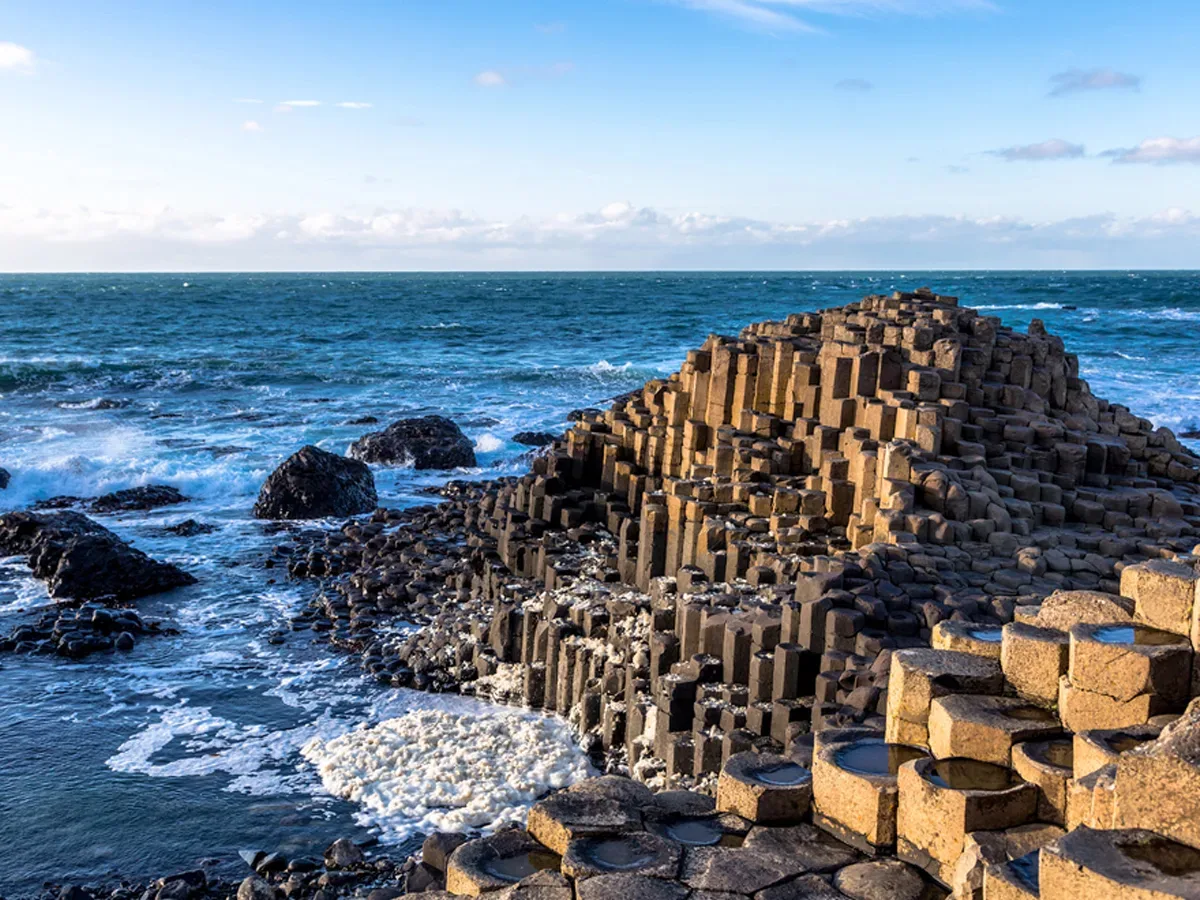IRELAND DREAM TOUR


Trip Overview
Ireland has more myths and legends than you’d dare to believe. It has more gorgeous coastlines and majestic mountains than your camera could capture. And there’s enough lively bars to satisfy even the most dedicated of partygoers. So, join this tour and explore all of it on our most comprehensive tour. You’ll delve into the tragic history of the Titanic, follow in the footsteps of giants, and get to know Irish pub life. Experience the richness of Ireland’s culture from North to South with this complete 12 day tour of the Emerald Isle.
- Chauffeur
- 2 Countries
- 12 Days
- 11 Nights
About This Tour
Day 1: Dublin City Tour
Dublin is a dream come true for book lovers. As a UNESCO City of Literature, it’s been home to literary legends like James Joyce, Oscar Wilde, and W.B. Yeats. Stroll through the Dublin Writers Museum, or lose yourself in the awe-inspiring Trinity College Library, home to the famous Book of Kells. Literature isn’t just a legacy here—it’s alive in every corner of the city, ready to inspire you. Dublin: where history, humor, and harmonious melodies collide. It’s a city of literary legends, lively pubs, and statues with nicknames like “The Tart with the Cart.” Whether debating the best Guinness or dodging cobblestones, things to do in Dublin are endless.
Day 2: Malahide - Newgrange - Monasterboice
Malahide is famous for Malahide Castle and Gardens, a historic 12th-century castle with over 800 years of history owned by a single family for centuries, as well as its charming seaside village atmosphere, with beautiful sandy beaches, a bustling marina, and fine restaurants.
Newgrange is famous for being an ancient Stone Age passage tomb, older than the Pyramids of Giza, that is precisely aligned to illuminate its inner chamber with the Winter Solstice sun on December 21st. This phenomenon, where sunlight enters through a roof-box and travels the length of the passagewa.
Monasterboice is famous for being an important early Christian monastic site in Ireland, especially known for its exceptionally preserved high crosses, which are among the finest examples of early Christian sculpture in Europe. The site features Muiredach’s High Cross, a 10th-century masterpiece with detailed biblical carvings.
Day 3: Discover Belfast
Belfast is famous for being the birthplace of the RMS Titanic, as the capital of Northern Ireland, for its industrial heritage including its former status as the world’s largest linen producer and shipbuilding center, and for its complex history during the “Troubles” which has given way to a vibrant modern city known for its street art and cultural attractions. The city’s cultural scene includes the world-renowned Titanic Belfast museum, colorful mural tours, and sites like the Harland and Wolff shipyard and the Albert Memorial Clock.
Industrial and Maritime History
RMS Titanic: The city is most famous as the place where the “unsinkable” RMS Titanic was designed, built, and launched. You can visit the Titanic Quarter and the interactive Titanic Belfast museum at the shipyard site.
Shipbuilding: Belfast was home to the Harland and Wolff shipyard, one of the world’s largest, and its iconic cranes still loom over the city.
Linen Production: At one point, Belfast was the largest producer of linen in the world.
Day 4: Dark Hedges - Giant's causeway - Dunlace Castle
The Dark Hedges became famous as an atmospheric natural landmark and a popular filming location for the HBO series Game of Thrones, where it was featured as the King’s Road. This avenue of 18th-century beech trees, originally planted to impress visitors, creates a beautiful, mystical tunnel that has become one of Northern Ireland’s most photographed and famous locations.
The Giant’s Causeway is famous for its thousands of unique, interlocking, hexagonal basalt columns, a stunning geological formation created by volcanic activity over 50 million years ago, which has also inspired the legend of the Irish giant Finn McCool. Designated as Northern Ireland’s first UNESCO World Heritage Site, its geological significance, striking appearance, and rich folklore make it a globally recognized natural wonder.
Dunluce Castle is famous for its dramatic cliff-top location on the Antrim coast, its historical significance as a stronghold of the McDonnell clan, its appearance in the TV series Game of Thrones as the House of Greyjoy’s Castle of Pyke, and for being a possible inspiration for C.S. Lewis’s Castle of Cair Paravel in The Chronicles of Narnia.
Day 5: Glenveagh - Mount Regal - Slieve League
Glenveagh is famous for its breathtaking natural scenery within its national park, the stunning Glenveagh Castle and its elaborate gardens, a large herd of red deer, and its history of hosting famous visitors like Marilyn Monroe. The park also holds significance for the reintroduction of the golden eagle and the turbulent history of its original owner, John George Adair, who orchestrated the Derryveagh Evictions.
Mount Errigal is famous for being Donegal’s tallest peak and an iconic, often-photographed mountain in Ireland, known for its distinct conical shape, the pinkish glow of its quartzite, and its unique appearance that shifts depending on the viewing angle. It’s the most prominent of the Seven Sisters mountain range and is a popular destination for hikers and nature lovers.
Slieve League is famous for being among the highest sea cliffs in Europe, offering dramatic coastal scenery and breathtaking views of the Atlantic Ocean and Donegal Bay. It is a significant stop on the Wild Atlantic Way and provides a more rugged, less crowded experience compared to other tourist spots. The site also boasts an early Christian monastic site at the summit and hiking trails for experienced walkers, adding to its appeal.
Day 6: Donegal - Mullaghmore - Carrowmore
Donegal is famous for its dramatic natural scenery, particularly the Slieve League cliffs and numerous sandy beaches, its rich history as the seat of the O’Donnell clan, and for its traditional culture, including renowned musicians like Enya and the distinctive dialect and Irish-speaking Gaeltacht areas.
Mullaghmore is famous for two primary reasons: its status as Ireland’s most famous big wave surfing spot, attracting professional surfers to its powerful, dangerous waves, and for its spectacular natural scenery, including Mullaghmore Head, the iconic Classiebawn Castle, and views of the Benbulben mountain.
Carrowmore is famous as the oldest and most concentrated Neolithic (Stone Age) site in Ireland, a megalithic cemetery containing over 35 passage tombs built around 6,000 years ago, and is significant as one of the largest such sites in Europe. The site is a key part of the ‘Passage Tomb Landscape of County Sligo,’ a proposed World Heritage Site, due to its historical importance in understanding Neolithic beliefs and funerary practices.
Day 7: West Port - Victorian Garden - Clifden
Westport, County Mayo, is famous for being a picturesque and popular destination known for its Westport House, a historic estate with a theme park, and the Great Western Greenway, a cycling and walking trail along Clew Bay. The town is also a base for visitors heading to the holy mountain of Croagh Patrick and is renowned for its charming, planned layout, lively atmosphere, and traditional pubs.
Victorian gardens are famous for their ornate designs, meticulous order, and abundance of vibrant, often exotic, plants, reflecting the era’s technological advancements, global exploration, and desire for elaborate displays of wealth and knowledge.
Clifden is famous for being the “Capital of Connemara,” a bustling hub for the region’s stunning natural beauty, outdoor activities, and cultural heritage. It’s particularly well-known for the internationally recognized Connemara Pony, scenic drives like Sky Road, its vibrant arts festivals, and being a gateway to the Wild Atlantic Way.
Day 8: Galway - The Burren - Cliffs of Moher
Galway is famous for its vibrant cultural scene, hosting numerous festivals like the Galway International Arts Festival and the Galway Races, its rich tradition of Irish music, its lively atmosphere in pubs and on the streets, its historic “City of Tribes” nickname, and its beautiful location on Ireland’s west coast, near the Wild Atlantic Way and the Aran Islands.
The Burren is famous for its unique karst limestone landscape, an unusual combination of Arctic, Mediterranean, and Alpine flora that grows together, and its thousands of archaeological sites. It’s also recognized as a UNESCO Global Geopark and offers dramatic scenery, underground caves, and inspiration for artists and writers, including a potential link to Tolkien’s Lord of the Rings.
The Cliffs of Moher are famous for their spectacular natural beauty, dramatic 702-foot-high cliffs, and diverse seabird colonies, making them a top natural attraction in Ireland. They are a popular tourist destination featured in films and literature and are a must-see destination for their scenic views and connection to Ireland’s cultural and natural heritage.
Day 9: Doolin - Adare - Muckross House
Doolin is famous as Ireland’s traditional music capital, renowned for its year-round folk music sessions in local pubs and its popular Doolin Folk Festival. It is also famous for the Doolin Cave, home to the Great Stalactite, and its access to the Cliffs of Moher and the Aran Islands.
Adare, Ireland is famous for being a remarkably picturesque village known as “Ireland’s Prettiest Village,” featuring charming thatched-roof cottages, the historic Adare Manor luxury resort, and ancient religious sites like Adare Friary. It’s a popular tourist destination due to its fairytale appearance, rich history from the Middle Ages, high-end amenities, and the opportunity to explore local crafts and award-winning dining.
Muckross House is famous for being a magnificent Victorian mansion set in the heart of the beautiful Killarney National Park, its historical connection to Queen Victoria’s 1861 visit, and its subsequent donation to the nation as the foundation of Ireland’s first national park.
Day 10: Killarney - Ring of Kerry - Torc
Killarney is famous for its spectacular scenery within and around Killarney National Park, which includes mountains, lakes, and woodlands; its historic attractions like Ross Castle and Muckross House; its role as the gateway to the Ring of Kerry; and its vibrant town with traditional pubs and restaurants.
The Ring of Kerry is famous for its breathtaking natural beauty, including dramatic coastlines, sparkling lakes, and rolling green hills, as well as its rich history and cultural sites, such as ancient forts and the Derrynane House, home of the statesman Daniel O’Connell.
“Torc” in Ireland refers to both a popular natural attraction, Torc Waterfall, famous for its beauty and myth, and the ancient Celtic neck or arm jewelry called a torc, prized for its cultural significance and symbolism of status and protection. Torc Waterfall, located in Killarney National Park
Day 11: Caha Pass - Garinish Island - Kinsale
The Caha Pass is famous for being part of the Ring of Beara scenic drive and offering dramatic, breathtaking views of the Caha Mountains and the surrounding wilderness. Travelers use it to drive from Glengarriff to Kenmare, traversing a route that includes hairpin turns, tunnels, and high vantage points overlooking Bantry Bay.
Garinish Island is famous for its internationally renowned botanical gardens, which thrive due to the island’s unique microclimate, blessed by the Gulf Stream. Created by Annan Bryce and Harold Peto, the gardens feature a rich variety of exotic and tender plants that change color with the seasons.
Kinsale is famous for being Ireland’s “Gourmet Capital” with a renowned culinary scene, its vibrant, colorful buildings, a picturesque harbor, and its rich history, including the site of the historic 1601 Battle of Kinsale.
Day 12: Cork - Rock of Cashel - Kilkenny
Cork, Ireland is famous for its vibrant culinary scene, including the historic English Market; Blarney Castle and its famous stone; a rich history of rebellion and notable figures; the starting point for the Wild Atlantic Way scenic route; and its renowned jazz festival. The region’s natural beauty.
The Rock of Cashel is famous for its significance as the historic seat of the Kings of Munster, its connection to St. Patrick, its spectacular collection of medieval architecture, including a round tower, Gothic cathedral, and Cormac’s Chapel with unique Romanesque frescoes, and as a picturesque, iconic landmark in County Tipperary, Ireland.
Kilkenny is famous for its well-preserved medieval history and architecture, including its iconic Kilkenny Castle and the historic St. Canice’s Cathedral with its round tower. It’s also a center for the popular Irish sport of hurling, has a rich crafts and design scene, and is known for its yearly festivals like the Kilkenny Arts Festival.
Tour Highlights
- Explore the old town of Dublin
- Visit Killarney,
- Enjoy the scenic view of the Mount Prigal.
- Step back in time through medieval castles.
What’s Included?
- 8 Seaters luxury private Minivan
- Professional Chauffeur/Guide
- Complimentary bottle of water
- Free Wi-Fi onboard
- Admission Tickets (if option selected)
- City Congestion and Parking
- Hotel pick-up and drop-off
- 10 hour full-day private tour
- Chauffeur accompanies the clients on tour.
- Driver can't enter sites
- Tips / Gratuities

